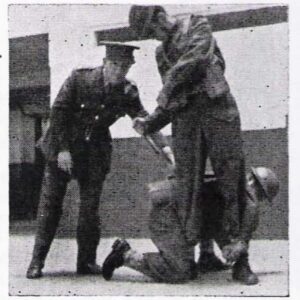Long ago, in my nights in the Capoeira roda my “jogo” was noted for a number of characteristics. One was a very well-timed front thrust kick that many of my companions never saw coming until they were staring at the sole of my foot. My other characteristic was how rarely I would use techniques that took me close to the ground. I had been a small child who had grown to above average height as an adult. Deliberately making myself shorter in front of an opponents was something that did not come naturally to me. Also, given my height such moves were somewhat slower for me than when performed by some of the shorter Capoeirista. My height and the related traits may have been the reason that I did not pay particular attention to the Ankle Clamp throws when I was rereading “Arwrology” the other week. Why would I use an Ankle Clamp throw when a shoulder jerk or head twist is a very more natural and quicker technique for me?
The other night I was relaxing at home watching TV when there was a sequence where a female character was ordered to her knees by the bad guy. That might be a good situation to turn the tables with an ankle clamp throw! The love of my life is about a foot shorter than me and half the weight (or less!). Obviously some of the techniques that I favour are not so useful for her. Fools who want to give themselves an illusion of power often make their intended victims beg or grovel. I’m sure many of my readers can think of various ruses where they might get into position for a counter attack such as the ankle clamp.
Arwrology describes the Ankle Clamp as having four variations depending on which side of the foe you are on and whether your head is “face forward” or “back”. I am going to describe the technique in my own words in the hope that an alternate description may make it easier for some students to understand.


Readers who have read my book will know that I prefer to teach the underlying physical and anatomical principles of a technique. Ankle Clamp is fundamentally the same as many throws: you disrupt the foe’s balance and prevent him changing his footing to compensate.
I will describe two variations of Ankle Clamp since the significant parameter is whether you place your bent knee before or behind the enemy’s foot.
Approach the foe from the side and position your bent knee so that it is in front of his nearer foot (pic. above). Your other foot is placed behind the foe, sole down and thigh parallel to the ground. This is important since the upward thrust from this leg powers the technique. You can rest your same side arm on your knee, which acts as an aide memoire. Since your bent knee was placed in front of the foe your torso goes behind his legs. Once your feet are in position do not hesitate in continuing the technique. You need to be smooth and fast to prevent the enemy realizing what you are up to and countering you. In the photo above the officer is drawing attention to the foe's dagger and that the throw needs to me completed before this can be employed on the thrower.
The arm that is nearest to the enemy we will call the “lead arm” (right arm in the photo above). The other arm, the one you can rest on your thigh we will call the trailing arm. Coil your leading arm around the outside of the foe’s far leg. At the same time slip your trailing arm between his legs and grip the wrist of your lead arm to join them together. You now use your arms to raise that leg up, thrusting down on the foot that is sole down to provide power. If you imagine you placed your bent knee to “the north” you are throwing the leg you hold to the south or south west. Effectively you are throwing the enemy’s balance north or north east and the position of your bent knee and the calf and thigh around it prevents him moving his other foot forward to compensate. These directions are approximate. How you break the foe’s balance will depend on an individual’s stance and reaction.


The other variation is when you place your bent knee on the ground behind the foe’s foot. This is the variation the book calls “Head Back”. Your other leg with the sole on the ground will be to the front or out to the side. Once again, you reach your lead arm around the outside of the foe’s leg. Your other hand slips between his legs and joins with the lead arm to lift his leg. The main difference is that in this variation you lead arm will reach across the front of his legs rather than coming from behind. Since in this variant the foe can look down and see what you are doing there is a greater chance of them kicking out or striking the thrower. The solution to this is to make the technique smooth, fast and without hesitation. As the Arwrology book says elsewhere “if anyone can see what you are doing, you are doing it too slowly!”
That is the essence of the Ankle Clamp throw. To make the technique more fluid the original book proposed a simple drill involving two lines of soldiers. One line was to be thrown, the second was tasked with catching the thrown man. A student would then precede down one line, throwing each man in turn. Once the entire line had been toppled the next student would do the same, and so on until each man had thrown dozens of different opponents using the Ankle Clamp.